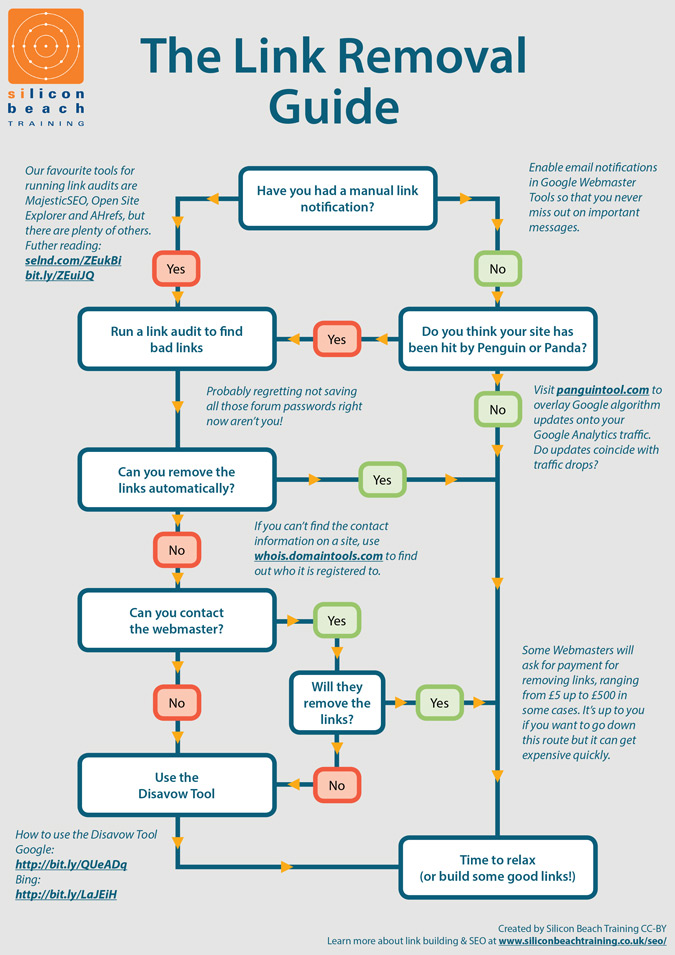Craig Charley
7 May 2013
Downloadable Link Removal Guide - When to Remove Links
One of the most common reasons that small businesses attend our SEO Courses is that they've had a Google link penalty - manual or algorithm - which have become part and parcel of SEO since the Panda update first reared its head.
With the increase in penalties has come an increase in link removals, but it's not always easy to know when to remove links, or even which links to remove. After all if you remove all your links then you're not going to rank for anything at all!
We decided to clear up the confusion surrounding link removal by creating a downloadable guide to removing links. Simply work your way through the guide to decide if and when to remove bad links, and how to go about doing it.
Click the image below to download the full PDF:

Share this: Twitter | Facebook | Google+ | LinkedIn
It's important to remember that links are no longer the be all and end all of SEO anymore. Personalised results based on location, preferences and search history now mean that no searcher has the same results. This is even more true for mobile searches, which is why we've just launched our one-of-a-kind Mobile SEO course that focused specifically on the mobile side of search.
Have You Had a Manual Link Notification?
Check your Webmaster Tools account for unnatural link penalty notifications, which mean that Google have taken manual action against your site.
If you haven't set up Webmaster Tools then it's essential you do; use our guide to using Webmaster Tools and make sure you set up email alerts so you don't miss important messages.
Do You Think Your Site Has Been Hit by Penguin or Panda?
If your search engine traffic has noticeably dropped but you haven't had a manual notification, it is likely that you have fallen foul of an algorithm update.
Panguintool.com is a great tool for checking to see if you've been hit with an algorithm penalty. It overlays algorithm updates onto your Google Analytics traffic.
If drops in traffic line up with algorithm updates, it's likely you've been hit. SEOmoz's Mozcast is also useful for keeping an eye on any fluctuation as a result of algorithm updates or data refreshes.
Run a Link Audit to Find Bad Links
Once you're certain that you've received a penalty, it's time to find the bad links that caused it.
Majestic SEO, Open Site Explorer and AHrefs are all tools we recommend, but there are plenty of other options available.
For a step-by-step walkthrough of running a link audit, check out these Search Engine Land and Search Engine Watch posts.
Can You Remove the Links Yourself?
Many links can be manually removed - by deleting a comment or stopping participation in a link wheel.
As mentioned in the Link Removal Guide, this is where a database or record of forum and site passwords comes in handy. If you haven't got a record of the password, your best bet is trying to reset it.
If you can't do that, it's time to get in contact with the webmaster.
Can You Contact the Webmaster?
Check the site for contact information. If there's none there then try whois.domaintools.comwhich will tell you who the site is registered to, although often this information is set to private on the spammiest of blogs, or the host information is shown instead of the webmaster. Bear this in mind with your link removal requests as often the person you are emailing will have nothing to do with the link you want removed.
Be friendly in your email and remember that you/ your client/ a previous agency built the link in the first place.
We often see a heavy handed approach where the initial email includes a threat - 'If you do not remove the link we will add your site to our Disavow Links report which will cause Google to penalise your site'. We don't recommend this approach, it's only going to get people's backs up and they're not going to want to cooperate with you.
Will They Remove the Links?
If you do manage to get in contact with the webmaster, they may agree to remove the links but for a price - sometimes as much as £500 per link!
If you're willing to spend to get rid of the links then that's up to you. This discussion in the Webmaster World forum, as mentioned by Barry Schwartz on his site, might convince you otherwise though.
Use the Disavow Tool
The disavow tool should really only be the last resort after exhausting all the options above. Ex-Google employees claim that Disavow Link requests are only checked alongside Reconsideration requests. These require proof that you have gone above and beyond to remove the links, so don't bother just adding all your links to the tool without putting the hard work in.
Remember that disavowing links is no guarantee that the penalty will be removed, although this article on SEO Wizz sings its praises. Even if your penalty is lifted, if the spammy links were the ones that pushed you to page one then you have to start from scratch.
Take a look at Google and Bing's guidelines for information on how to use the tool and this post, written when Google's Disavow Tool was announced, for more general information about it.
Hopefully that's helped you to better understand how and when to remove links.
If you've found this useful, please share it and let us know how you got on. What was the 'worst' link you found? What was the most money someone asked for to remove a link? Let us know in the comments.
